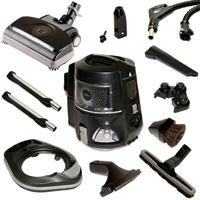I’m yet to meet anyone who admits to getting up and rejoicing that it’s time to get the vacuum cleaner out. But, if you want the cleanest living environment possible, vacuuming is an absolute necessity.
Vacuum cleaners help us to keep our homes clean, even getting into all the awkward nooks and crannies. And, to operate at their best, they rely on an airflow that sucks dirt from any given surface.
But over time, cleaners lose their suction, making it harder to get up all the dust, dirt and bacteria. And they always seem to have a knack of suction dropping at the most inappropriate times.
The Technical Bit (Short Version)
 Rainbow vacuums rely on a fan motor to generate enough suction to perform at their best. These motors then pull dirt through the hose and deposit it either into a bag or, in our case, water!
Rainbow vacuums rely on a fan motor to generate enough suction to perform at their best. These motors then pull dirt through the hose and deposit it either into a bag or, in our case, water!
Some Rainbow cleaners also have a brush attachment to help collect dust, dirt and debris. The brush agitates the dirt, then the airflow, under normal circumstances, sucks it up.
To be at its most efficient, all these functional parts of a cleaner need to be working at 100% capacity. If you’re getting reduced or poor suction in your Rainbow vacuum, then one of those parts may be faulty. Here are some possible reasons why your vacuum cleaner may have lost suction, and advice on how to fix it.
Dirty Filters
 Most newer Rainbow vacuum cleaners have two filters. One keeps dust out of the motor, and is called a separator. The other is a HEPA filter, which helps to keep the air you breathe cleaner.
Most newer Rainbow vacuum cleaners have two filters. One keeps dust out of the motor, and is called a separator. The other is a HEPA filter, which helps to keep the air you breathe cleaner.
Filters can be different, depending on your model; the good news is, you can clean them if they clog up. You’ll need to first understand how you can remove them safely. Then it’s a simple case of following any washing instructions.
As with most breakable things in life, prevention is better than cure. Get into the habit of unclogging your filters before your vacuum begins to lose suction.
Periods between cleaning or unclogging will differ from owner to owner. Regularity, area and whether you’re working in heavily trafficked areas will dictate those periods.
Vacuum Airflow Issues
Vacuum cleaners work most effectively when the airflow is seamless. Airflow begins at:
- the tip of the hose for the canister type of cleaner;
- the base opening for the upright cleaner.
You can diagnose canister airflow issues by gently inserting a stick into one end of the tube. If you find an obstruction, use the stick to gently dislodge it.
Also, inspect the outside of the hose from end to end. If you notice any cracks or holes, these could be the cause of your loss of suction. To get the power of your suction back, replace any cracked or broken hoses straight away.
For upright vacuum cleaners, the loss of suction may have a different root cause. Begin checking by first turning the unit upside down (ask for help if you need it). Next, check that the opening points directly to the vacuum body.
Look for any dirt that could have impeded the suction. If your unit has a rotating brush, remove it to gain better access to the opening.
Also, always check the point where the hose and vacuum connect. A loose connection here will compromise the airflow and reduce the suction.
Motor Problems
The motor generates the suction force that enables your vacuum cleaner to work. If the motor has problems, the cleaner will automatically lose airflow.
You may notice issues with the motor if the sound it produces differs from the sound you’re used to hearing.
Unfortunately, the mechanics of motors are, by their nature, technical. If your motor gives up the ghost, your only option may be to replace it.
That said, some motors use a blade to generate its suction force. If that’s the case, you may only need to replace the blade, not the entire motor.
What If None of the Above Solutions Work for Me?
Above, we’ve listed the most basic causes of loss of suction in Rainbow vacuums. But if you don’t feel confident with your diagnosis, don’t worry. You’re not alone, and help is at hand.
A Rexair authorized technician will know almost all causes of poor suction by heart. They understand the how the different types of cleaners work, and any inherent problems.
Use their experience and diagnostic skills to isolate the problem and have them fix it for you. They’ll let you know the best repair option based upon your model.
In some cases, the damage might mean that upgrading is a better option for you. A manufacturer authorized technician can offer all the support and succour you need to get your home spotless again.

Follow Us: